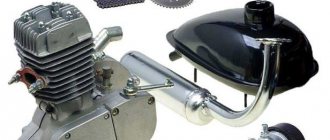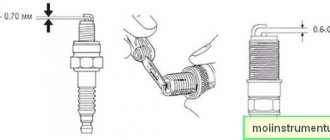Which gasoline to choose for a boat motor?
There are some nuances in choosing gasoline and general recommendations for diluting gasoline with oil. It is best to follow them, no matter what type of outboard motor and boat you have:
- remembering obvious things that, nevertheless, are forgotten, most often a certain type of gasoline for a boat motor is indicated in the passport for your unit. You just need to carefully study the instructions for the outboard motor. There are usually written down in black and white the types of gasoline that are suitable for the boat. If you purchase the right fuel, then the various parts of the engine work very well, and the engine will not fail and will last a very long time;
- but boaters often argue about which gasoline is best for which vessel. This is due to the fact that Russian oil refineries produce only gasoline labeled 92. The same fuel that is considered 95th fuel at gas stations is actually the same 92nd gasoline, which has an increased octave number. It should be noted that its octave number is quite increased due to the fact that there is an iron-containing anti-detonation additive, methyl tert-buphyl alcohol and propane butane;
Gasoline for boat motor
- at the moment when gasoline burns, which contains the addition of methyl tert-butyl alcohol, ether and benzene, carbon deposits form on the so-called pistons. This can often lead to breakage or partial jamming. Methyl alcohol is hydroscopic, so it absorbs moisture from the air. As a result, in your gas tank you find, so to speak, replacement 95th gasoline, which will be divided into the original 92nd gasoline and water, which will settle to the bottom;
- We can conclude that propane-butane will, in principle, not cause much damage to your parts, since it evaporates quite quickly. And after this, 95th gasoline again becomes the original 92nd fuel. The overpayment for 1 liter is about 30 percent. We can draw the following conclusion: if there is no imported fuel at the gas station, it is best to fill in Russian 92nd gasoline.
Practical guide for correct preparation of the mixture
Before deciding how to mix oil and gasoline for a trimmer, you should complete organizational issues. This includes the following points:
- Storage of technical fluids. For gasoline, it is better to provide a metal canister, and leave the oil in the original container. For convenience, it is allowed to use a special two-section canister.
- Volume of prepared mixture. Do not prepare a large amount in advance. It is better to pour gasoline into the lawn mower, taking into account the planned amount of work. The homogeneity of the mixture will be impaired during long-term storage.
- Tool for preparing the mixture. The ideal device for oil selection and dosage accuracy is an analogue of a medical syringe. This will not only allow you to accurately measure the liquid, but also make it convenient to use.
By the way, when buying oil, do not make a large supply. It is enough to buy the amount that you can spend during the season.
We dilute in the correct proportion
The problem of how much oil to pour into gasoline for a trimmer is aggravated by bringing different proportions from different sources. For example, the following discrepancy is often encountered:
- the proportion of 1:40 is indicated in the instructions for the unit;
- value 1:25 on the plastic container of the fuel tank;
- proportion 1:50 in a plastic container for preparing the solution.
If you have the slightest doubt, pay attention to the packaging of the oil. When determining the volume of oil to be poured into gasoline for a lawn mower, the properties of the liquid are taken into account
It is taken into account that two-stroke engines do not like oil starvation
At the same time, excessive enrichment of the mixture with oil is perceived capriciously
It is taken into account that two-stroke engines do not like oil starvation. At the same time, excessive enrichment of the mixture with oil is perceived capriciously.
When determining how much oil will need to be added to gasoline for a trimmer, use the standard proportion. For one liter of gasoline, divide 1000 ml by 50 to obtain a volume of oil measuring 20 ml. If the volume to be filled is 500 ml, then the amount of lubricant is reduced proportionally. It is easy to calculate the amount of gasoline for large volumes. If you need to prepare a mixture for a mowing team, you will need 200 ml of oil per 10 liters of gasoline.
What to add
Uniform mixing is important. Therefore, when adding oil per liter of gasoline to the trimmer, use the following algorithm. Half of the gasoline is mixed with the entire required volume of oil. After thorough mixing, adjust the volume of the mixture to the nominal volume by adding the remaining gasoline.
Keep all containers, including the mixing container or gasoline can, clean. You should not use improvised containers made of unprepared plastic to prepare the mixture. Even small portions of impurities or debris will cause the carburetor to fail. After preparation, it is better to pour gasoline into the trimmer using a container with a device that will protect the mixture from spilling.
If you break the ratio
When operating, try to remember how much oil per liter of gasoline is needed for the trimmer, even with single refills. For example, when extracting the last drops of oil from a container, it is a mistake to think that a one-time violation of the proportion will not change anything.
How to dilute chainsaw oil - expert advice
5/5 — (3 votes)
In this publication we will explain in detail how to properly dilute oil for a chainsaw, trimmer or any two-stroke engine. What oil is best to dilute gasoline with, what proportion to maintain, and also what the wrong dosage can lead to - you will find out the answers to all these questions here.
Oil, or additive as it is also called, is the most important component of the fuel mixture for a chainsaw. During the operation of the two-stroke mechanism, oil molecules settle on the internal combustion engine (cylinder walls, crankshaft, connecting rod) and create a sliding protective film. Thus, the physical contact of rubbing parts is significantly reduced.
Content:
|
| ¦¦ THIS IS INTERESTING ¦¦ |
|
Proportion of oil to gasoline for a chainsaw |
Many users simply forget in what proportion it is necessary to dilute oil with gasoline for a modern chainsaw or trimmer. There is nothing shameful here, because most people ask this question literally several times a year. This information can be easily found in the instructions for the equipment, but it’s not so simple. For example, Chinese manufacturers often confuse us and write a ratio of 1:20 or 1:25 in the passport. This proportion is dangerous for the mechanism, which we will talk about a little further.
Correct proportion:
for our conditions (existing brand of oil on the market and quality of gasoline) it is only
1:50 (rarely 1:40)
. In other words, 1 gram of oil per 50 ml of gasoline.
amount of AI-92 gasoline, l quantity of 2T oil, ml proportion 1:50 proportion 1:40 0,5 10 ml 12.5 ml 1 20 ml 25 ml 1,5 30 ml 37.5 ml 2 40 ml 50 ml 5 100 ml 125 ml 10 200 ml 250 ml
AI-92 gasoline is used
. No 95, which in fact is the same 92, only with a bunch of additives that are extremely harmful for a two-stroke engine (since these additives dampen the proper detonation of the mechanism).
Important: In some cases, it is possible to add a little more two-stroke oil than usual (not 20 grams per liter, but 22-25 grams). For example, during running-in of a chainsaw after repairing the piston group or in the case of using cheap Chinese oil.
What oil is best to dilute gasoline for a chainsaw with? |
It's no secret that every chainsaw manufacturer recommends using a two-stroke additive of its own production. But not everything is so simple here. If you buy an inexpensive Chinese chainsaw, then of course it would not be a bad idea to dilute it with oil from famous, trusted brands. So which oil is best to dilute gasoline with? — there is no one correct answer and this is influenced by a number of factors:
- During warranty
. Most reputable manufacturers recommend using only their own oil. In the event of a warranty claim, if the service discovers that you have refilled with a different brand of oil, it has every right to refuse free service. - Proven brands
. Stihl, Echo, Husqvarna are well-known and trusted brands. This is the best thing on the market. Using branded two-stroke oil, you don’t have to worry about your equipment at all. - Cheap oil (Russian or Chinese)
. These are Champion, Rezer, Krotof, Patriot and many others. It is quite possible to use it, in some cases by slightly increasing the proportion of oil in the mixture. You should carefully consider your choice - read reviews, ask people. For example, our service was not at all impressed with Gazprom two-stroke oil - already 2-3 days after dilution with gasoline, it begins to lose its properties. - Beware of counterfeits
. Mostly Stihl oil is counterfeited. Similar options can be found at collective farm markets or among gypsies. Try to buy 2T oil in specialized stores from official dealers. - No 2-stroke boat engine oil
. It is not suitable for chainsaws and trimmers, because... designed for a water-cooled system, not an air-cooled one.
How to easily dilute the additive with gasoline |
Only seasoned users who can accurately determine the proportion with an experienced eye can dilute two-stroke oil with gasoline “by eye.” But even they are often mistaken in this case. Here are several options for correct and quick adjustment of the gasoline mixture:
- A syringe and a small container
are important for those who rarely use a chainsaw or trimmer. It is better to buy a 20 cc syringe, available at any pharmacy. - Factory packaging with a dispenser
costs a little more than a regular bottle, but is very convenient. - A special canister
- this is loved by professionals who saw all day long and most likely with more than one chainsaw. - Single-use packaging
includes bottles and sachets of 20, 50 or 100 grams. Compared to a large bottle, it’s not very profitable, but some people don’t want to bother with measuring the proportion.
Be careful when mixing gasoline and oil. These are flammable substances, and in the wrong hands they pose a danger to health and even life. Follow safety precautions! The mixing process itself is quite simple and primitive:
- Find a clean container, preferably dark in color (food grade plastic is not suitable).
- First, fill in AI-92 gasoline
- Then add the adjusted dose of two-stroke oil.
- Shake everything thoroughly - this is important (including after the already diluted mixture has been left idle for some time).
| ¦¦ THIS IS INTERESTING ¦¦ |
|
How to store chainsaw oil |
As a rule, the shelf life of two-stroke oil is at least 3 years. This applies specifically to pure oil (additive), provided that the packaging (bottle) is completely sealed. An already diluted mixture of oil and gasoline is a completely different matter. Many people mix it at once for the whole summer, for a year, etc. This is a very serious mistake!
The recommended shelf of diluted gasoline with oil is 2 weeks
. If you use inexpensive Chinese or Russian oil, it is better to reduce this period to one week. For example, even expensive high-quality Stihl synthetic oil retains its properties by 80% after 3 weeks of storage. There is no need to talk about other brands.
So why can’t you dilute oil with gasoline “in reserve”
.
Firstly, gasoline loses octane number over time. Secondly, the oil in gasoline gradually loses its properties. The additives in it dissolve in an aggressive environment and as a result, only the color remains. The consequences here are sad - engine overheating and expensive engine repairs (CPG).
Bottom line: dilute as much gasoline mixture as you plan to use, based on the intended amount of work. If there is old surplus left, it should be disposed of, even the one that remains in the tank of the chainsaw or gas trimmer.
Consequences and signs of incorrect proportions |
Oil is added to gasoline to reduce the friction force of the mechanism, we already talked about this at the beginning of the article. Therefore, an incorrectly diluted or expired gasoline mixture will certainly result in dire consequences.
If you do not add enough two-stroke oil.
The engine will run without proper lubrication and will quickly overheat. This leads to scuffing/deformation of piston group parts. Chinese technology is especially susceptible to this. Often, repairing a piston engine is not economically feasible and stupid oil savings are the usual “death” of a chainsaw.
Symptom:
Mainly, the unit starts to heat up faster than usual. Vibration may occur, increasing as the speed increases. In some cases, the chainsaw or trimmer simply will not start - but this is even good, since you will have time to correct the critical error.
If you overfill two-stroke oil.
An excess of oil in the fuel mixture is just as harmful as an insufficient amount. The expression “you can’t spoil the oil filling” is completely inappropriate here. This only does not appear immediately, but after some time. To put it quite simply: during engine operation, the excess amount of additives simply does not burn out and is gradually deposited on the walls of the CPG. What does this lead to:
- The formation of carbon deposits on the walls of the cylinder/piston - it cokes and falls out - scuffs form on the piston. The engine will need major repairs.
- Excess fuel can spit out onto the air filter - cleaning the system and buying a new filter will save you.
- The muffler becomes clogged - the exhaust gases simply have nowhere to go and the chainsaw or trimmer literally begins to choke under load. Plus, coked scale from the muffler can fly into the cylinder - again, piston repair.
- Soot accumulates on the candle, it turns black and becomes unusable.
Sign:
Everything is quite simple here. If you add too much two-stroke oil to gasoline, the chainsaw or trimmer will literally smoke/smoke when operating. Moreover, the more it is poured, the more smoke there will be.
Is it possible to mix two-stroke oil of different colors? |
In order to answer this question, you need to understand the two main types of oil. Based on its basis, two-stroke oil is divided into mineral and synthetic.
Mineral
2T chainsaw or trimmer oil is more common (as it is cheaper) and is usually red in color. There are also blue and even yellow colors. You can mix them, nothing critical will happen, but it is precisely in the situation “there is red gasoline left in the tank, but you need to fill up blue.”
Synthetic
two-stroke chainsaw oil (usually green) has a high cleaning effect and burns out much more efficiently during engine operation. Plus, its lubricating properties are better. Simply put, it is better than mineral, but also costs more.
Semi-synthetics
This is a mixture of the above
.
We will not focus on this type of two-stroke oil (usually blue), since it should be treated the same as the synthetic version.
Here's how not to stir two-stroke oil:
- You cannot use synthetic oil after mineral oil. Mineral oil still leaves a small deposit in the CPG over time, which will begin to be actively “washed away” by synthetics. All the dirt will start flying into the piston and scratch it. The result is expensive and complex repairs. But after synthetics, it’s quite possible to switch to mineral water.
- If you want to mix mineral oil of different colors in liters/canisters, this is not recommended. This also applies to mixing synthetic additives with each other.
| ¦¦ THIS IS INTERESTING ¦¦ |
|
Conclusion |
A properly diluted gasoline mixture for a chainsaw (trimmer) is the most important factor in its safety and stable operation. The most important thing to understand from this article is to maintain a clear proportion of oil and gasoline. The two-stroke mechanism is harmed by both its excess and its deficiency in the gasoline mixture. Yes, some error is acceptable, but only very small.
Pay special attention to the brand of oil; it is better to choose a branded one, even if it is expensive. This is not a case where you can save money. Agree that piston repairs will cost an order of magnitude more.
Follow safety precautions and have a good job!
4.3 9 votes
Article rating
Features and principle of operation of the 2t engine
Any owner of a motorcycle should have an understanding of the design of the engine and the principle of its operation. The two-stroke power unit is used not only in motorcycles, but also in other technical devices - gas mowers, trimmers and others. Despite the fact that many models of modern equipment are equipped with four-stroke engines, the two-stroke engine is still widely used. It is easy to operate, convenient to maintain and repair, and is also quite reliable.
The operating cycle of such an engine is carried out in a couple of compression and power strokes as a result of the energy from the ignition of the fuel. Both cycles are carried out during one revolution of the crankshaft. A two-stroke engine does not have the fuel mixture intake phase and the exhaust cycle, characteristic of four-stroke engines. The process of fuel intake and exhaust gas exhaust occurs during the compression and expansion phases.
Thanks to this design feature, the torque and power developed by the engine are increased at the same cubic capacity as a 4-stroke engine. And although the efficiency of a two-stroke power plant is lower compared to a four-stroke one, due to the two-stroke operation of the piston, the engine elements perform fewer movements. Provided that the mating parts of the motor are properly lubricated, it has a fairly long service life and is less susceptible to internal wear.
For a two-stroke to function, it is necessary to turn on the ignition, ensure the fuel supply and crank the engine crankshaft with a starter or kickstarter.
The two-stroke power unit is used not only in motor vehicles.
Further operation of the two-stroke engine is carried out according to the following algorithm:
- The piston begins to move towards the spark plug from bottom dead center. At this time, the fuel mixture enters the working chamber of the cylinder. The exhaust window, designed to allow exhaust gases to escape, opens and the working mixture is compressed;
- in the initial phase of the compression cycle, a pressure difference occurs in the chamber of the crank mechanism, facilitating the entry of a new portion of gasoline. In the upper phase of the piston movement, the working mixture is ignited by a spark from a spark plug;
- The energy resulting from the combustion of gasoline forces the piston to move to the lowest point. Thanks to the open channel of the exhaust window, exhaust gases exit through the elbow connected to the muffler;
- subsequent movement of the piston causes the purge channel to open and gasoline to flow into the working area of the cylinder. The phase of displacement of the piston to the lowest point completes the working cycle of the motor and the cycle repeats.
In the process of supplying gasoline mixed with oil, the components of the power unit are lubricated. This distinguishes the lubrication system of a two-stroke engine from the lubrication system of a four-stroke engine, which has a gear pump to supply oil to the area of the mating parts of the engine.
Oil mixed with gasoline provides lubrication in the crank mechanismWhat happens if you pour waste into a chainsaw?
If you don’t want your chainsaw to fail at the wrong moment, use only high-quality fuels and lubricants. Mixing waste with gasoline is prohibited. The reasons for this are the following factors:
- The viscosity of the material is different, so the grinding is not capable of providing effective lubrication of rubbing parts and mechanisms
- The waste contains small particles of metal and shavings, which, if they enter the tank, will cause clogging of the fuel filter and channel. If the lubricant gets into the cylinder along with small particles, they will leave their mark in the form of accelerated wear of the piston rings
- Emission of large amounts of black smoke, indicating oil burning
You cannot pour surrogate materials not only into the gasoline tank, but also into the chain lubrication tank. What happens if you use waste in the tank to lubricate the chain can be seen in the video.
Using the instructions, you can independently prepare the correct fuel mixture for the chainsaw to operate on. If the fuel mixture is diluted incorrectly, not only does the service life of the tool decrease, but its performance also decreases.
Intervals when you need to replace
The service book for the vehicle specifies the mileage after which the lubricant solution must be replaced. In the absence of intense operating conditions, driving on the highway outside the city, the mileage between lubricant changes can be up to 15,000 km. Operating vehicles in city traffic will reduce mileage to 9000-11000 km. But these data are not completely accurate, since the condition of the lubricant is influenced by several factors, which include:
- Type and quality condition of the fuel being filled.
- Power plant volume.
- The type of lubricant that was previously filled and its condition.
- The number of hours worked by the engine.
- Technical condition of the vehicle.
- Vehicle operating conditions and power plant operating modes.
These factors can change the quality of the lubricant. Loss of its characteristics by the lubricant will lead to rapid wear of the power plant. In such a situation, an analysis of the oil solution carried out in laboratory conditions can give an accurate answer about the quality of the lubricant and the need to replace it.
The ratio of gasoline and oil for lawn mowers
- Standard proportions
- Mixing Rules
- Consequences of violation of the ratio
- How to choose a lawn mower?
Petrol mowers are a fairly common technique for controlling weeds in summer cottages, gardens, roads and housing and communal services. These devices have two more names - trimmer and brushcutter. These units differ in their engines. The more expensive ones have four-stroke engines, all the rest have two-stroke engines. Of course, the latter are the most popular among the population, since they are simpler in design, lighter in weight, and significantly cheaper than their four-stroke competitors. However, two-stroke models are inconvenient in that the fuel mixture for them must be prepared manually, maintaining a strict dosage between gasoline and oil. In four-stroke analogues, mixing of these components occurs automatically; you just need to fill the gas tank and oil tank with the appropriate substances. Let's consider the question of the correct refueling of two-stroke lawn mowers, since this determines how effective and long the operation of such a unit will be.
Why mix oil and gasoline?
Most people are used to handling four-stroke engines.
Even in motorcycles, this type of engine is now more common than two-stroke engines. The requirement in itself to pour oil into gasoline does not lead to an understanding of the process. After all, in conventional car engines there is a whole system that prevents the mixing of oil and fuel. The whole trick is in the design features of low-power internal combustion engines with two cycles of operation. They are very simple in design and do not have an oil pan and a pump that would pump liquid lubricant to the right places. The crankcase contains only the cylinder and the crank mechanism with the crankshaft.
To ensure lubrication, the designers took a different route: they arranged the channel system in such a way that the fuel not only penetrates the combustion chamber, but also washes the moving components on the back side of the piston. Since the lubricating properties of gasoline are clearly insufficient to reduce friction, oil is added to it. By the way, due to these features, the rings on the piston are exclusively compression rings, there are no oil scraper rings.
Tools
The Patriot RT 3355 petrol trimmer is designed for trimming and mowing low-growing grass on lawns, streets, around trees, along roadsides, on lawns and garden plots. The unit is successfully used on both flat and embossed, uneven areas. The manufacturer has improved the model taking into account convenient transportation and easy use: the rod is detachable, quickly assembled and disassembled. The wide shoulder strap with adjustable length adds comfort to use. Quick start is simplified due to the primer.
- Description of the Patriot RT 3355 model
- Preparing and pouring the fuel mixture into the Patriot RT 3355 trimmer
- Stages of launching a gasoline trimmer Patriot RT 3355
Description of the Patriot RT 3355 model
- A universal unit: the use of a fishing line allows you to carry out work on cutting lawns and flower beds; changing to a cutting knife allows you to cut dead wood, weeds with a hard or elastic stem, and trim shrubs.
- Comfortable management and operation. The use of innovative vibration protection in the design, selection of the optimal balance of the tool.
- Ergonomic technology handle and shoulder strap.
- The primer makes starting easier and takes the load off the starter.
- Maintenance is accessible and convenient. If necessary, quick repairs and troubleshooting of problems in the ignition and filtration compartment are carried out.
- Engine power 1.8 hp allows you to productively perform continuous work for 4-4.5 hours.
- Engine capacity 033 l.
- Sharp knife with a diameter of 230 mm. Knife rotation speed 8000 rpm.
- Strong, reliable fishing line with a diameter of 2.4 mm.
- Working width 460 mm.
- Bicycle style handle.
- Net 6.6 kg.
- Gross 8.6 kg.
- Overall dimensions 95 x 36 x 23 cm.
Preparing and pouring the fuel mixture into the Patriot RT 3355 trimmer
- The mixture for a two-stroke engine is prepared only from original Patriot oils and high-octane gasoline AI 92.
- For preparation, use a special canister included with the trimmer. The markings are adapted for gasoline and oil of the specific model 3355.
- Gasoline is poured to the mark for gasoline fluid.
- The appropriate brand of Patriot oil for a two-stroke engine is poured into it.
- With several shakes, the mixture is brought into a homogeneous state.
- The mixture is prepared in a regular gasoline canister at a gasoline/oil ratio of 32:1.
- Preparing the fuel mixture directly in the trimmer tank is not recommended.
- It is recommended to prepare a portion of the mixture for one, maximum two dressings.
- The mixture should be poured with the engine turned off, away from sources of open flame.
Stages of launching a gasoline trimmer Patriot RT 3355
- The freshly prepared mixture is poured into the tank.
- The choke lever is moved up to the “cold” position.
- The ignition on the control knob is set to the “on” position.
- Press the primer button 5-7 times to fill the carburetor with the mixture.
- The trimmer is placed on a stable surface at a safe distance from objects and people. Avoid contact of the trimmer head or cutting blade with the ground.
- The gas trigger on the control handle is pressed and locked in this position.
- Hold the trimmer with one hand and pull the starter handle with the other hand until it engages. At this moment the handle jerks sharply until the engine starts.
- Set the choke lever to the middle position.
- The starter handle must be pulled several times before the engine starts.
- Warm up the engine for 5-10 seconds. Move the choke lever down. Press the gas trigger to unlock.
- Smoothly pressing the gas trigger, bring the engine to maximum speed. They start working.
- Mowing is carried out by holding the trimmer firmly by the ergonomic handles.
- For a warm engine, perform the above operations without pressing the primer. In this case, the air damper is placed in the lower position.
How to prepare a fuel mixture for a trimmer
But such results are real if you know exactly how much oil to add to gasoline for a garden trimmer. The fact is that two-stroke engines run on a mixture of gasoline and oil. The fuel enters the cylinder, burns there, creating a working force on the piston, and that part of the oil that does not have time to ignite lubricates the moving parts of the piston group. When preparing a mixture for a trimmer, a strictly defined amount of oil must be added to a liter of gasoline. If there is too little lubricant, the friction force will become too great and the engine will jam, and if there is too much oil, the oil will flood the spark plug and the engine will stall. Also, if there is excess oil, the engine power will decrease, it will not develop the required speed and smoke heavily.
When compiling a fuel mixture, it is necessary to calculate how much oil is needed per liter of gasoline, based not only on the standard proportion, but also on what brand of gasoline and oil is used
In the case of two-stroke engines, this is very important.
The prepared mixture of gasoline and oil can be stored for no more than 3 months (pure gasoline can be stored less). Dilute the fuel in an amount that is enough for several uses of the trimmer. In general, prepare:
- gasoline and oil, which is suitable for two-stroke engines with an air cooling system;
- metal canister and mixing container;
- respirator;
- gloves.
Dilution instructions:
Pour 1 liter of gasoline into a container of suitable volume and add 1/2 of the required amount of oil. Stir carefully, being at a good distance from sources of open flame. Add the remaining half of the oil to the fuel and mix everything again.
General recommendations for refueling a trimmer with a two- or four-stroke engine:
- Place the fuel tank so that the cap is on top, then fill in the required amount of fuel.
- Do not overfill the fuel tank. This will lead to one of the problems: overflow into the intake pipe and fuel filter, ignition of the fuel or engine breakdown.
- Try to pour the mixture so that it does not spill. To do this, you can use a watering can.
- If you do spill fuel, wipe it up immediately. Dispose of cleaning material; do not accumulate it indoors - it is a fire hazard.
- Start-up of the device should begin after the fuel canister has been removed to a distance of more than 10 m.
- If there was a long break between uses of the mower, be sure to drain the remaining old fuel.
Why is gasoline mixed with oil to refuel chainsaws?
It is necessary to dilute gasoline with oil to avoid failure of the internal combustion engine. The reason for this is the design features of the lubrication system of two-stroke engines. The design of such engines does not have a chamber for filling engine oil, and if fuel is added without lubricant, the crankshaft, piston, bearings and connecting rods will not receive lubrication. This will significantly reduce the service life of all listed parts, so filling with clean fuel is prohibited.
Gasoline and chainsaw oil must be poured in appropriate proportions, which makes it possible to effectively lubricate the rubbing parts. A lack of lubricant or its excess will lead to negative consequences in the form of carbon deposits. In order for the tool to work properly, from the first day of operation of the tool it is necessary to fill it not only with high-quality materials, but also to maintain the correct proportions.
It is important to know! A two-stroke engine must be filled with gasoline with an octane number of at least 92. Many experts argue that Russian or Ukrainian fuel can only be filled with an octane number of at least 95, which is due to its low quality.
In order for the engine to work properly, the main thing is to fill it with clean fuel without contaminants.
Peculiarities
It should be noted that the gasoline scythe is very easy to operate. It is enough to see how other users use this unit to start using it fully. Performing basic technical functions is intuitive and does not require any difficulties in practice. Properly running in a gasoline trimmer is also not difficult. Moreover, there is almost no difference between devices of the household and professional categories.
The key difference is the type of motor. On professional equipment it is more powerful and produces more revolutions. The two-stroke engine is more often used in household models. Four-stroke units are more reliable and produce more force, so they are suitable for special conditions, complex and overgrown areas.
Fuel mixture proportions
If the mixture is diluted correctly, for example, following the instructions below, then the equipment will serve you for many years without serious technical breakdowns. In this case, fuel consumption will be low and the work result will be high. The process of preparing fuel should always be the same and constant. It is better to always use the same ingredients, without changing the brand specified by the manufacturer.
You shouldn’t add a lot of oil, as this can damage the engine’s performance, but you shouldn’t skimp on it either. To maintain the correct proportions, always use the same measuring container so as not to make mistakes with the quantity. To measure the oil, you can use medical syringes, but some manufacturers also provide measuring containers with marks along with the oil.
The most correct ratio of oil and gasoline is considered to be 1 to 50, where 50 is the amount of gasoline and the amount of oil is 1. For a better understanding, let us explain that 1 liter is equal to 1000 ml. This means that to get a proportion of 1 to 50, we divide 1000 ml by 50, we get 20 ml. As a result, only 20 milliliters of oil need to be added to 1 liter of gasoline. To dilute 5 liters of gasoline you will need 100 ml of oil.
In addition to maintaining the correct proportions, it is also necessary to observe the technology for mixing the ingredients. Under no circumstances should you simply add oil to the gas tank. It is better to follow the following step-by-step instructions.
- To dilute the mixture, you need to prepare in advance a container in which you will mix gasoline and oil. This can be a clean metal or plastic canister with a volume of 3, 5 or 10 liters to make it easier to calculate the amount of oil. Do not use drinking water bottles for this purpose - they are made of thin plastic that can be dissolved by gasoline. To measure oil, use a special measuring container. But if there is no such thing, then, as already noted, medical syringes with a large dosage are suitable.
- Pour gasoline into the canister, without adding a couple of centimeters to the full volume. To avoid spilling gasoline, take a watering can or insert a funnel into the neck of the canister. Then take the required amount of oil into a syringe or measuring device and pour it into a container with gasoline. It is not recommended to do the opposite - pour gasoline into oil.
- Close the cap tightly with the bottle and stir the resulting mixture. If some of the fuel spills out while preparing the mixture or stirring it, you must immediately wipe the canister with a dry cloth.
- Be sure to follow fire safety precautions. Dilute the mixture away from fire and under no circumstances leave residual fuel and used materials within the reach of children.
And one more important point: it is better to prepare exactly the amount of mixture that fits in the fuel tank of your brush cutter. It is not advisable to leave any remaining mixture.
Consequences of incorrect dosage
Many chainsaw users don't pay enough attention to proportions. 50 grams more or less - does it matter? But in vain: often the cause of saw malfunctions is operation with an incorrectly prepared fuel mixture. Moreover, you can make a mistake or intentionally violate the ratio either up or down.
If there is a lot of oil...
There is an opinion among chainsaw owners that “you can’t ruin an engine with oil.” But it’s not for nothing that they come up with the necessary parameters for the finished mixture. Excess oil can also be harmful and cause inconvenience. Indeed, despite the improved combustion characteristics without residue, some hydrocarbons still turn into soot and carbon deposits. At low concentrations there are few of them, but if you enrich the mixture with oil twice as much as the norm, then coking will result. This is especially dangerous for cheap mineral oils that do not have a “washing” effect.
It is also highly likely that you will find oil in the air filter when the carburetor is overfilled. The candle will also be sooted - it will need to be cleaned, rinsed and dried. Also, vapors from unburned oil will settle in the muffler, and during intensive operation they will burn out, forming a trail of soot and sparks.
After such refueling, almost all the insides of the saw will have to be thoroughly cleaned and rinsed. The funniest “surprise” will be the “dying” of the piston rings - but this is only in the case of systematic abuse of oil overflow and work under heavy load.
...or little
“Greed” when preparing the fuel mixture has ruined more than one piston.
This is where it really is better to be “overcautious” than to be “underdressed.” After all, if in the first case you are faced with a thorough “washing” of the unit, then in the second you will have to change the CPG, and this is generally unprofitable on many saws, but for others it costs quite a lot of money. Conclusion: saving is pointless. If there is not enough oil, the piston begins to rub strongly against the cylinder, since at high temperatures gasoline is too fluid to act as a lubricant.
Sad result: scuff marks on the piston, ruined saw engine. If the owner comes to his senses in time, he will find that the piston and cylinder are cast in a beautiful blue. No master can give a guarantee how long these will last.











